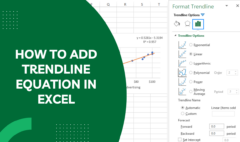Where is Preferences in Excel?
April 21, 2023 2023-06-20 18:59Where is Preferences in Excel?
Where is Preferences in Excel?
In the world of spreadsheets, Microsoft Excel has established itself as a powerful tool for data analysis, calculation, and visualization. To cater to individual needs and enhance user experience, Excel provides various customization options, allowing users to personalize their work environment.
One such essential feature is the preferences settings, which enable users to modify and fine-tune Excel’s behavior according to their specific requirements. In this article, we will explore how to access and utilize the preferences in Excel effectively as well as give you a few examples and demonstrations of customization options you can modify. So, keep reading to discover how to make Excel work best for you.
Understanding Excel Preferences
What are preferences?
Preferences in Excel are the customizable settings that determine the behavior and appearance of the software. These settings allow users to tailor Excel to their preferences, making it more efficient and user-friendly. By modifying preferences, users can configure options related to calculation, display, editing, security, and more.
Importance of preferences in Excel
Excel preferences play a crucial role in streamlining your workflow and optimizing productivity.
By customizing various settings, you can simplify repetitive tasks, enhance data entry and manipulation, and make Excel adapt to your specific needs. Understanding how to access and utilize preferences effectively can significantly improve your Excel experience.
Accessing Excel Preferences
To access the preferences in Excel, follow these step-by-step instructions:
Step 1: Launch Excel on your computer.
Step 2: Click on the “File” tab located in the top-left corner of the Excel window.

Step 3: In the File menu, click on “Options” at the bottom of the left sidebar. This will open the Excel Options dialog box.

Step 4: Within the Excel Options dialog box, you will find various categories on the left side, such as General, Formulas, Proofing, etc. These categories represent different sections of preferences that you can customize.

Let’s have a look at a few of the categories available in the Excel Options dialog box
Customizing General Preferences
The General category of preferences allows you to modify the basic behavior and settings of Excel. Here are a few options you can customize:
Changing default file format:
Step 1: Access the Save in Excel Preferences.

Step 2: Locate the “Save files in this format” dropdown menu.

Step 3: Choose your preferred file format from the list, such as Excel Workbook (.xlsx) or Excel 97-2003 Workbook (.xls).

Adjusting calculation options:
Step 1: Navigate to the Formulas category in Excel Preferences.

Step 2: Customize settings related to calculation options, such as automatic or manual calculation, precision, and iterative calculations.

Modifying language settings:
Step 1: Open the Language category in Excel Preferences.
Step 2: Choose your preferred language for Excel’s user interface and editing tools.

By customizing these general preferences, you can align Excel with your preferred file formats, calculation methods, and language settings.
Modifying Display Preferences
Excel provides several options to modify the display preferences, allowing you to adjust the visual appearance of your worksheets. Here are some display preferences you can customize:
Adjusting the default font and font size:
Step 1: Go to the General category in Excel Preferences.

Step 2: Locate the “When creating new workbooks” section.

Step 3: Choose your preferred font and font size from the respective dropdown menus.

Changing the gridline settings:
Step 1: Access the Advanced category in Excel Preferences.

Step 2: Scroll down and adjust the settings for gridlines, such as hiding or displaying them.

Managing Formula Preferences
Excel’s formula preferences allow you to configure various settings related to formula calculation and display. Here are a few formula preferences you can customize:
Adjusting calculation settings:
Step 1: Go to the Formulas category in Excel Preferences.

Step 2: Modify calculation options, such as enabling iterative calculations, maximum iterations, and maximum change.

Changing formula display options:
Step 1: Access the Advanced category in Excel Preferences.

Step 2: Customize the options for displaying formulas, such as showing formulas instead of their results.

By managing these formula preferences, you can fine-tune Excel’s behavior related to formulas and calculations.
Conclusion
In conclusion, understanding how to access and modify preferences in Excel is essential for maximizing efficiency and customizing the software to suit individual needs. While the location of preferences may vary depending on the version of Excel being used, this blog post has provided several demonstrations to help users navigate the interface and locate the preferences menu.
By exploring the preferences options, users can unlock a range of useful features and tailor Excel to their specific requirements. Whether it’s adjusting default settings, customizing the Ribbon, or fine-tuning calculation options, preferences empower users to work smarter and faster with Excel. So don’t hesitate to dive into the preferences menu and make Excel work for you!









